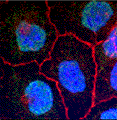Biochemistry, Department of
Document Type
Article
Date of this Version
2018
Citation
Differentiation. Front. Physiol. 9:879.
Abstract
Triggering an appropriate protective response against invading agents is crucial to the effectiveness of human innate and adaptive immunity. Pathogen recognition and elimination requires integration of a myriad of signals from many different immune cells. For example, T cell functioning is not qualitatively, but quantitatively determined by cellular and humoral signals. Tipping the balance of signals, such that one of these is favored or gains advantage on another one, may impact the plasticity of T cells. This may lead to switching their phenotypes and, ultimately, modulating the balance between proliferating and memory T cells to sustain an appropriate immune response. We hypothesize that, similar to other intracellular processes such as the cell cycle, the process of T cell differentiation is the result of: (i) pleiotropy (pattern) and (ii) magnitude (dosage/concentration) of input signals, as well as (iii) their timing and duration. That is, a flexible, yet robust immune response upon recognition of the pathogen may result from the integration of signals at the right dosage and timing. To investigate and understand how system’s properties such as T cell plasticity and T cell-mediated robust response arise from the interplay between these signals, the use of experimental toolboxes that modulate immune proteins may be explored. Currently available methodologies to engineer T cells and a recently devised strategy to measure protein dosage may be employed to precisely determine, for example, the expression of transcription factors responsible for T cell differentiation into various subtypes. Thus, the immune response may be systematically investigated quantitatively. Here, we provide a perspective of how pattern, dosage and timing of specific signals, called interleukins, may influence T cell activation and differentiation during the course of the immune response. We further propose that interleukins alone cannot explain the phenotype variability observed in T cells. Specifically, we provide evidence that the dosage of intercellular components of both the immune system and the cell cycle regulating cell proliferation may contribute to T cell activation, differentiation, as well as T cell memory formation and maintenance. Altogether, we envision that a qualitative (pattern) and quantitative (dosage) crosstalk between the extracellular milieu and intracellular proteins leads to T cell plasticity and robustness. The understanding of this complex interplay is crucial to predict and prevent scenarios where tipping the balance of signals may be compromised, such as in autoimmunity.
Included in
Biochemistry Commons, Biotechnology Commons, Other Biochemistry, Biophysics, and Structural Biology Commons



Comments
Copyright © 2018 Barberis, Helikar and Verbruggen.
Open access
doi: 10.3389/fphys.2018.00879